by Tim Lagasse – Please contact me with any questions – territorialriders@bcho.org
The Mt. Hood National Forest has some steep and rugged country, and Bull of the Woods Wilderness is probably some of the most rugged and isolated country in the Mt. Hood. In addition, in 2010, a significantly sized, and very hot, forest fire burned out the center of Bull of the Woods and also damaged many of the trails in the process. In years and decades past, many of our members had previously ridden the trails in Bull of the Woods, and at the urging of Jerry Bentz and the late Guy Jones TRBCHO adopted the Bull of the Woods Wilderness area as one of our primary work efforts late in the summer of 2012, shortly after our chapter formed.
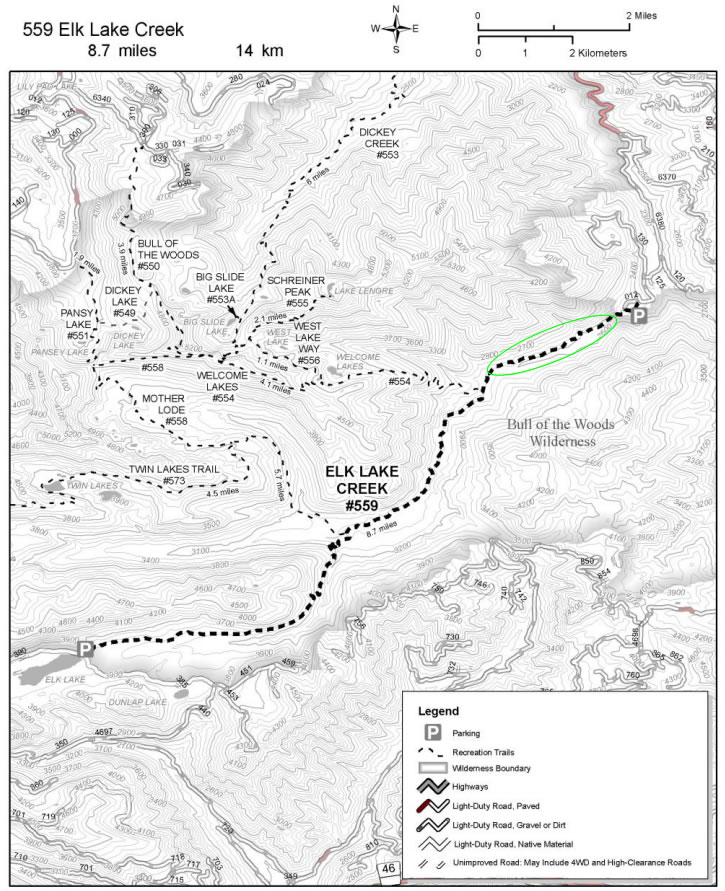
The Forest Service was excited about our desire to work in Bull of the Woods as the Clackamas Ranger District had no trail crew at the time to perform any of the badly needed maintenance on the trails, let alone tackle the damage caused by the 2010 fire. With guidance from the Forest Service regarding the priority of getting trails back in shape we started work on trails in Bull of the Woods in the late summer of 2012. Our first task was to clear the Pansy Lake trail up to the Motherlode trail. Once arriving at the remote trailhead we saddled up, donned our cross-cut saws and headed up a pretty nice pansy lake trail wondering where all the burned areas we had heard about were? Well, when we crested the hill and connected with the Motherlode trail it was not hard to miss the complete devastation on the other side of the hill. Fields of match-sticks standing on the hills was all that was left to the south. Fortunately, we turned onto the Motherlode trail that day and headed east to the fire lookout and back to our trailers with our highest priority trail complete and moving on to priority number two, the Elk Lake Creek trail.
It wasn’t too long after our first work party occurred that our Chapter President in 2012, Joanne Hanson, tried to ride in on the Elk Lake Creek trail. Her scouting ride only lasted about a half mile when they had to turn around at a rather large fallen log across the trail at an area in the burn that had a significant side-slope. The trail itself in that area was around 12-18” wide with some places that were missing due to washouts because of the loose, burned soil that lacked any organic root material to hold the soil together. With our limited scouting report in hand we set out on foot in the following weeks to cut out the burned logs because there was nowhere to tie the horses and mules while we were cutting. We performed three trips on foot in the fall of 2012 prior to snow ending the work season and cut out approximately thirty logs across the steep side slope that eventually flattened out into a heavily burned area. We had cleared about three-quarters of a mile in from the trail head.
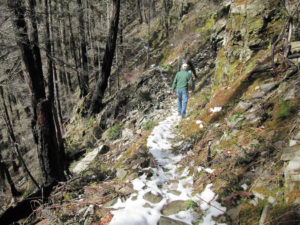
Once the snow cleared in 2013 and we had our annual fundraising ride and other trail work completed we again focused on Elk Lake Creek trail in mid-July. We started on foot again since we did not know what was in the steep section near the beginning of the trail. Progress was good since we had cut out many logs the previous year using our crosscut saws. On our first trip of the year we had cut to a point approximately one mile in and were ready to quit for the day when we decided to just look around the corner to see what was next. Interestingly enough, we found the Wilderness Boundary sign hanging on a tree. We also realized that we had just cut out all those logs that were outside the Wilderness with crosscut saws over four trips instead of probably one trip with a chainsaw. We did learn a valuable lesson that day; never assume the Wilderness Boundary is where the permit box is located near the beginning of the trail. Always consult the map!
Now that we could use the horses, we decided to camp at the trailhead and perform weekend campout trips since the trailhead was approximately 60 miles from town. Over the course of six weekends we cut approximately 70 logs off the trail and had progressed about 5 miles down the trail. Bees had started getting pretty bad since we were into the late August and early September time-frame.
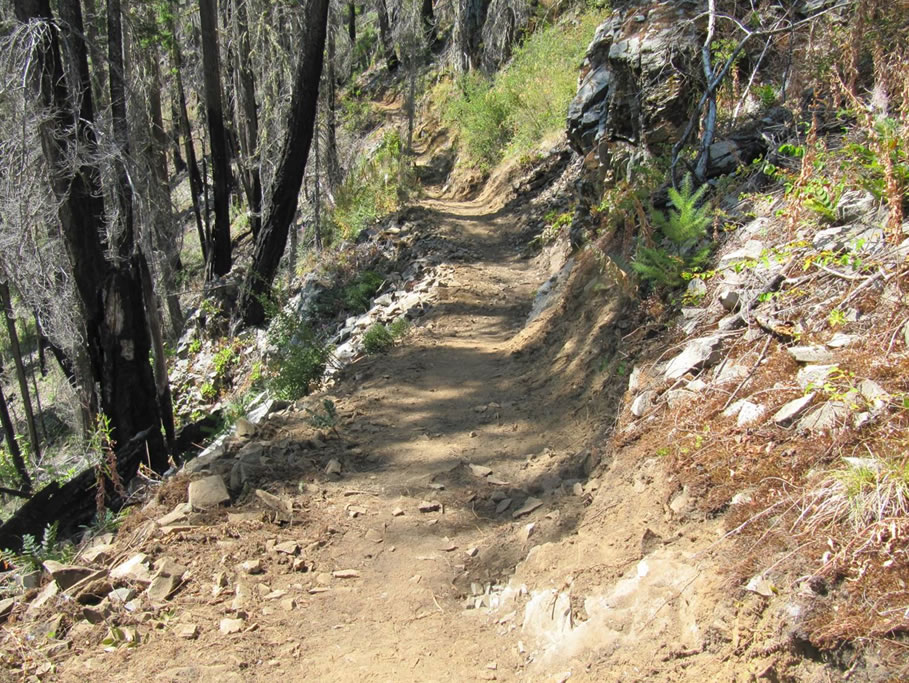
Our work on the Elk Lake Creek trail ended abruptly the first weekend of September due to a wreck that was most likely caused by a bee sting to my riding horse that caused my riding horse and pack horse to end up off the trail in the area of the steep side slope. Unfortunately, there was no recovery due to the loose soil from the burn and the steepness of the hill. Sparing the reader the details, suffice to say that both my riding horse and my pack horse perished that day and our work on the Elk Lake Creek trail also came to an end until we could find a way to rebuild the trail in a manner that provided some measure of safety through a pretty treacherous area of trail across the steep side hill and cliff at the bottom.
In mid-2015, we caught wind that a new Recreational Trails Program (RTP) grant cycle would open in March of 2016. Our chapter voted to let me look into the possibility of applying for an RTP grant to obtain funding for a youth crew to widen the Elk Lake Creek trail along the steep side hills and restore the burned areas of trail in the first mile of trail, along with fixing a difficult water crossing at two miles in.
One of the first steps toward obtaining a grant is to get approval from the managing agency; in this case the managing agency was the U.S. Forest Service (USFS). We had worked with the USFS on a number of previous projects ranging from building corrals at Riley Horse Camp to trail re-routes on the Sandy River trail, and they agreed that the proposed ELK Lake Creek trail project would be a good project to partner up on. As part of our discussion, I walked the project trail segments with Tom Triscik, our Clackamas River Ranger District Wilderness Trails Technician, and Tom estimated the project would need approximately 4 weeks of youth crew to complete.
The next step was learning whether our project actually qualified for the RTP grant program and if so, how to apply for the grant. RTP in Oregon is administered through the Oregon Parks and Recreation Department (OPRD), and OPRD put on an invaluable class in February of 2016 that answered most of the questions we had. The class also provided an opportunity to meet the OPRD RTP staff, who were very helpful in the grant application process by answering any additional questions that came up.
For our February 2016 meeting I put together a PowerPoint presentation that explained what I had learned at the OPRD training meetings and laid out the preliminary plan to widen the trail and restore the burned area and the Welcome Creek crossing utilizing (4) weeks of youth crew work plus our volunteer match. The financial estimate for the project was a total project value of $45,200 which was comprised of the $9,200 20% match requirement for our chapter and $36,000 to be granted by the Federal Highway Department through OPRD to pay for the youth crew. There was a pretty substantial amount of uncertainty by some of the members, and justifiably so, about what would happen if we were not able to live up to the requirements of the grant. Would there be any penalties for non-completion? Could we field enough volunteers to meet the volunteer match of $9,200 worth of labor required to fulfil our 20% obligation? How did the fact that RTP is a reimbursement grant program affect our ability to live up to the terms of the grant, and so on.
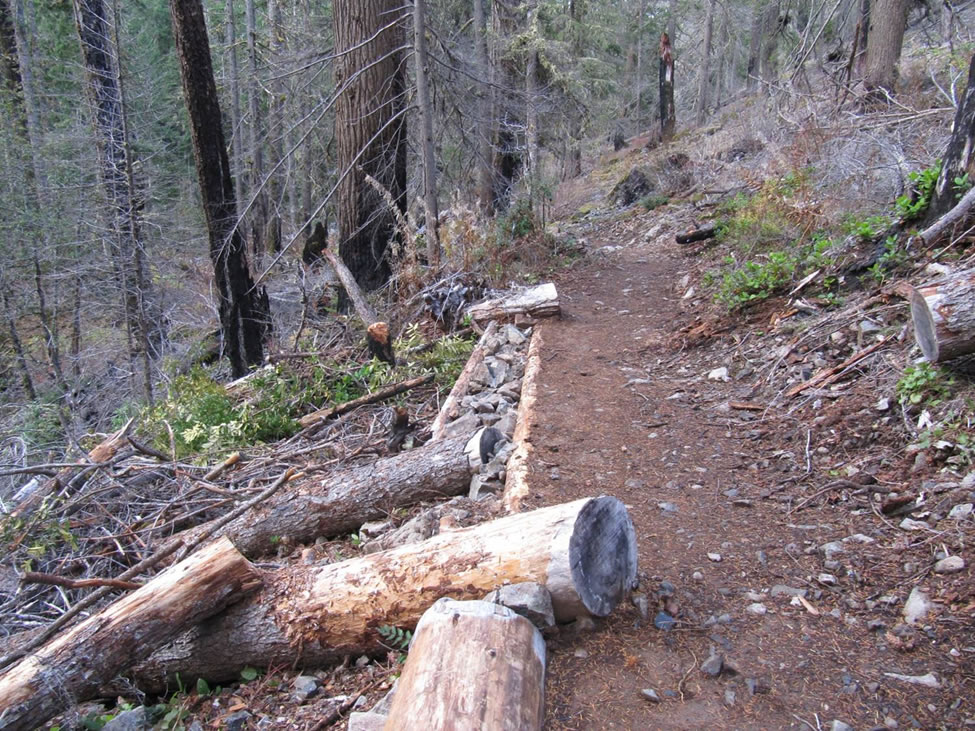 The discussion on whether or not to apply for the grant was very spirited. An important part of the discussion was that the Elk Lake Creek Trail is a beautiful riding trail once you pass the 1 mile mark. The problem was that at ½ mile in, there was this steep side hill section of narrow trail that pretty much limited use of the trail to only very experienced riders with tried and true equines. Many of our members would not ride this section of trail due to the risk of trouble, and as I found out first hand, any type of problem could cause a very bad day even for a rider with experience on this trail because there was just no margin for error along the side hill. Some of our members maintained that the trail did not need to be fixed but many recognized the benefits of fixing this trail. The majority of the chapter recognized that fixing this section of trail would lessen the risks in the area of the side hill to allow access for others who may not quite have as much intestinal fortitude as they did when they were younger, or perhaps may have equines that were a little less well trained, or perhaps they were just not quite crazy enough anymore to ride across that section to get to the gently sloped perfect riding the rest of the Elk Lake Creek trail offers. Fortunately, by the end of the discussion, we had a successful (though not unanimous) vote that authorized the chapter to apply for the grant.
The discussion on whether or not to apply for the grant was very spirited. An important part of the discussion was that the Elk Lake Creek Trail is a beautiful riding trail once you pass the 1 mile mark. The problem was that at ½ mile in, there was this steep side hill section of narrow trail that pretty much limited use of the trail to only very experienced riders with tried and true equines. Many of our members would not ride this section of trail due to the risk of trouble, and as I found out first hand, any type of problem could cause a very bad day even for a rider with experience on this trail because there was just no margin for error along the side hill. Some of our members maintained that the trail did not need to be fixed but many recognized the benefits of fixing this trail. The majority of the chapter recognized that fixing this section of trail would lessen the risks in the area of the side hill to allow access for others who may not quite have as much intestinal fortitude as they did when they were younger, or perhaps may have equines that were a little less well trained, or perhaps they were just not quite crazy enough anymore to ride across that section to get to the gently sloped perfect riding the rest of the Elk Lake Creek trail offers. Fortunately, by the end of the discussion, we had a successful (though not unanimous) vote that authorized the chapter to apply for the grant.
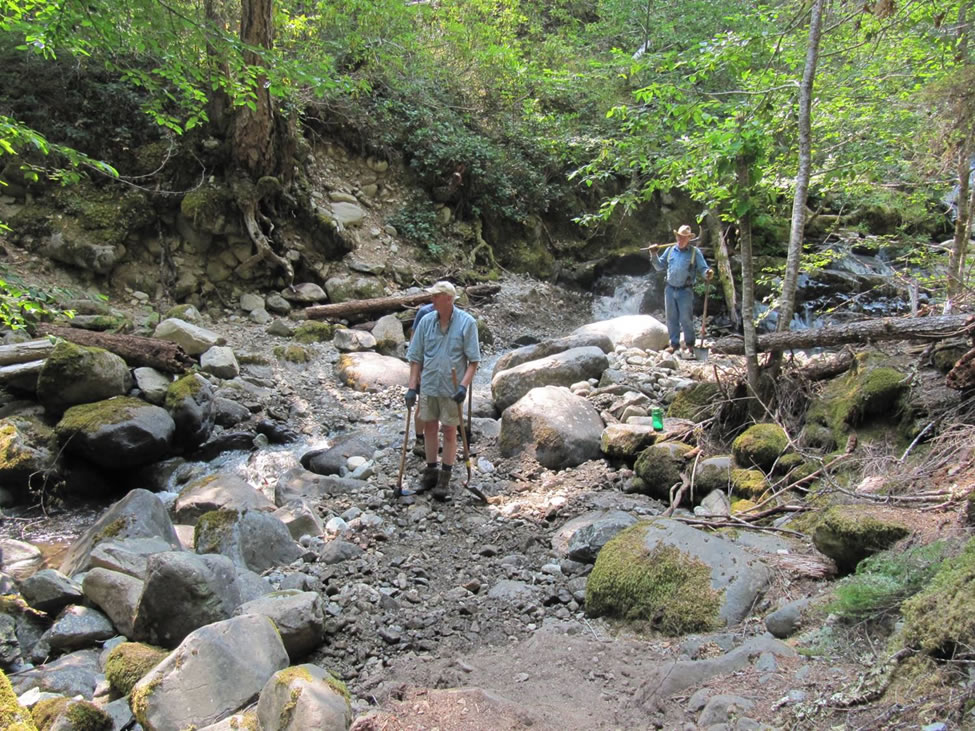 Continuing to read the instruction for RTP grants and getting questions answered by the OPRD staff, we put together our grant submittal through the online application process. There were numerous forms to fill out, projects plans to create, and letters of support required during the submittal process. One interesting issue happened to be the requirement for environmental analysis or (NEPA) if required. Fortunately, Jacki Groce, the USFS Clackamas River Ranger District Ranger was in support of this project and worked with us to supply the needed documentation. Once the grant was submitted by the March 2016 deadline it became a waiting game to see if we were successful.
Continuing to read the instruction for RTP grants and getting questions answered by the OPRD staff, we put together our grant submittal through the online application process. There were numerous forms to fill out, projects plans to create, and letters of support required during the submittal process. One interesting issue happened to be the requirement for environmental analysis or (NEPA) if required. Fortunately, Jacki Groce, the USFS Clackamas River Ranger District Ranger was in support of this project and worked with us to supply the needed documentation. Once the grant was submitted by the March 2016 deadline it became a waiting game to see if we were successful.
Turns out we were successful! RTP project are graded on a points based system where a committee awards point to the various answers provided to the questions in the grant application. Our project placed 8th highest out of around 43 applicants and the first 32 applicants were funded if I remember right.
Next we needed a Notice to Proceed before we could do any work that counted toward our match. Due to some turn over in the OPRD office and some other considerations the process took a bit longer than normal. By the time we received a grant agreement to sign, it was November and the snow was flying in the Mt Hood. Fortunately, our new OPRD grant administrator, Jodi Bellefeuille worked with us to allow us to sign the grant agreement in April due to some language in the contract that may have voided the agreement because we would not have been able to get to our worksite within a (6) month window to start work that was buried in the contract. Once April arrived and we got the grant agreement signed we received our Notice to Proceed, and we were off and running, sort of.
One of the first tasks was to figure out which youth crew to use. The application had required us to get (3) quotes, but we had not settled on who to use. Looking at the plusses and minuses of the three groups I asked David Nestor from Northwest Youth Corps (NWYC) come out and speak to the chapter about the Northwest Youth Corp organization. David made a great presentation about Northwest Youth Corps youth program that really hit home with our volunteer organization. We could tell right away that the things our group valued were emphasized in the NWYC program, and that working with NWYC would be right for our group.
Chris Nichols from the USFS also came to the May meeting as well to discuss USFS support, which was huge because cooperation with the USFS would result in training for us and also work on the project by USFS personnel would result in Force Labor hours which also contributed to our match dollars.
There was a lot of snow in 2017, so it wasn’t until early June that we were able to walk the trail with Jeff Olson from NWYC and Tom Triscik from the USFS to verify the youth crew could indeed perform the work in the (4) weeks allotted. We had a good hike and discussion on the trail and Jeff confirmed the youth crew should be able to complete the project in the four weeks Tom had originally estimated. One interesting note was that Jeff preferred working later in the fall after moisture would be present in the soil due to the powdery nature of the soil and the fact that winter snows would help pack the trail down after widening the trail to enhance trail sustainability. The September/October time frame looked good to Jeff, which also was good for us because that would give us time to get our match done so we could have a final vote to actually approve funding the grant from the TRBCHO treasury. More on this one later…
As the summer of 2017 continued, we ticked off our other work projects on the various trails we have adopted from May through the end of July, and by August we were finally able to focus on the Elk Lake creek trail. For our first work party we scheduled a (4) day event from Thursday, August 10, through Sunday, August 13. Since we would only have pack support on the weekend, we decided to work at Work Area 1, which was about ½ mile in, the first day. We accomplished a lot of work that first day with a crew of five which included (3) TRBCHO members (David Lynn, Marty DeVall, Tim Lagasse), (1) PCTA member (Roberta Cobb), and USFS support from Rachel Drake. We widened about 150 linear feet of trail to our goal of four feet wide across the steep side slope. The second day we decided to work on the Work Area 3 creek crossing moving rocks out of the creek bed with a group of four which included (2) TRBCHO members (Tim Jones, Tim Lagasse) and USFS cooperation with a crew of (2) USFS employees (Tom Triscik, Vito Perrone). With limited tools due to the 2 mile hike in (with no pack suppoet), we still got a ton accomplished with a come-along, a rock net, and a couple of rock bars that day. The third day we had pack support, and all the tools we needed to finish the Work Area 3 creek crossing. Our crew consisted of our pack support (Jerry Bentz and his mules), TRBCHO members (Marty DeVall, Tim Lagasse) and cooperation from the USFS (Tom Triscik, Vito Perrone). We moved literally a few tons of rock and opened up the creek crossing that day. Jerry packed out a portion of the tools so that we would have what we needed for the fourth day back in Work Area 1. The fourth day of the work party was another great day. We had Jerry Bentz pack the rest of the tools out from Work Area 3 (and Work Area 1 at the end of the day), and we had a crew of (3) TRBCHO members (Melissa Farrier, Marty DeVall, Tim Lagasse) and (3) from the USFS (Tom Triscik, Vito Perrone, and Ryan Bussman). The amount of work that got done was truly incredible. The USFS guys went to work on busting out rock that we had initially thought needed blasting. Once they got done, blasting was no longer required! By the end of the day, we had widened numerous feet of trail to our four foot wide requirement.
Amazingly enough, Over the (4) days we accomplished approximately $4,880.00 of the $9,200 required for match, so we were about 52% complete on match in (1) extended weekend work party. This was so amazing I sent out an update to the chapter of our progress and a notice regarding our next (3) day effort to occur (2) weeks later.
Unfortunately, in the two weeks between August 11 and August 25 2017, the fires started burning in the Mt Hood. Understandably, we would have no USFS help due to everyone fighting fire. Fortunately, our work area was open again after being closed for a few days due to a local fire caused by some ‘not so bright’ campers a week earlier along our access road.
On the Friday of August 25th we had an incredible (8) TRBCHO members (Rebecca Karlson, Phylis Elston, Julie Stanbro, Jeannie Sovince, David Lynn, Marty DeVall, Connie Smith, Tim Lagasse) arrive to work in Work Area 1. We had another really good day moving dirt, rock, and widening trail. Then, just when I thought it couldn’t get any better, Saturday came and TRBCHO members just continued to pull into the trailhead parking area. We had a whopping (13) TRBCHO volunteers (Stacy & Rich Livermore, Melissa Farrier, Marlon Smith, David Lynn, Marty DeVall, Siggi & Tom Maire, Barbara Schlitt, Madelyn Hendrickson, Nancy Haring, Cindy Croghan, Tim Lagasse) drive 60 miles into the Mt Hood National Forest to work on this project! Just plain incredible! We also had pack support that day from member Connie Smith to bring additional tools in and most of the tools out. We had so many people there that Saturday we did some napkin calculations on the trail and determined we had completed our match and then some after only two days!
With our match complete, it was time to vote to release funds for the trail crew. We held the vote at our September meeting and with a unanimous vote we authorized funding the youth crew.
I contacted NWYC shortly after our vote, and Jeff shuffled some projects around and the NWYC crew performed (4) weeks of work on the Elk Lake Creek trail in October 2017. They did an amazing job restoring the burned out trail tread area and finishing the widening project in Work Area 1. They also performed all of the Work widening the trail in Work Area 2 which completed the project.
November 1st I walked the trail with Jodi from RTP and marveled at the changes on the Elk Lake Creek trail. The whole length of the trail along the steep side hill went from 12”-18” wide to at least 48” wide, the burned out tread was restored, and another section of narrow tread along a steep side slope was widened in Work Area 2. We found only one issue during final review. During the last week of October we had a day where the Mt Hood received approximately four to five inches of rain. Our creek crossing at Work Area 3 had some small boulders move on the far side, so we will need to do some regular maintenance work there for 2018.
Overall, we logged over 300 hours of TRBCHO volunteer time, 3 days of pack support, and had cooperation from the USFS that resulted in 12 USFS Force Labor days on the trail. Our Match allowed a (4) week youth crew worth $32,000 to be hired for this project. The trail definitely shows it too. In 2018 we will be able to safely ride in to perform regular maintenance needs on the widened and restored Elk Lake Creek Trail in Bull of the Woods Wilderness.

